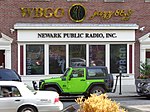Bush Tower

The Bush Tower (also the Bush Terminal Building, the Bush Terminal International Exhibit Building and formerly the Bush Terminal Sales Building) is a skyscraper in the Midtown Manhattan neighborhood of New York City, just east of Times Square. Designed by Frank J. Helmle and Harvey Wiley Corbett of the firm Helmle & Corbett, the building occupies a plot at 130–132 West 42nd Street between Broadway and Sixth Avenue. The Bush Tower was built for Irving T. Bush's Bush Terminal Company, which operated Bush Terminal in Sunset Park, Brooklyn, New York City. The 30-story section of the tower facing 42nd Street was developed between 1916 and 1918 and is 433 feet (132 m) tall. A 10-story wing, completed in 1921, extends south to 41st Street. The Bush Tower's design combined narrowness, height, and Neo-Gothic architecture, and the massing contains several setbacks to comply with the 1916 Zoning Resolution. The facade contains trompe-l'œil brickwork, which creates vertical "ribs" with a false "shade" pattern to enhance the building's verticality. It originally contained a buyer's club on its three lowest stories and exhibits on its upper stories. The Metropolitan Life Insurance Company foreclosed upon the tower in 1938 and the upper floors were subsequently converted for regular office usage. By the early 1980s, the Bush Tower had deteriorated significantly and the owners considered demolishing the building. It was instead renovated and was designated as a city landmark in 1988 by the New York City Landmarks Preservation Commission. As of 2015, China Vanke has a controlling ownership stake in the Bush Tower, while Tribeca Associates and Meadow Partners hold a lease on the land.
Excerpt from the Wikipedia article Bush Tower (License: CC BY-SA 3.0, Authors, Images).Bush Tower
West 42nd Street, New York Manhattan
Geographical coordinates (GPS) Address External links Nearby Places Show on map
Geographical coordinates (GPS)
| Latitude | Longitude |
|---|---|
| N 40.755 ° | E -73.985555555556 ° |
Address
Bush Tower
West 42nd Street 130
10036 New York, Manhattan
New York, United States
Open on Google Maps





